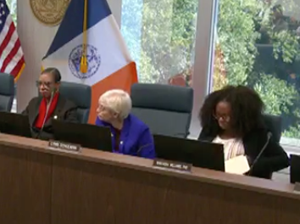Council Committees Back $413 Million Jamaica Rezoning, Paving Way for 11,800 New Homes

New York’s largest rezoning in decades portends substantial changes for Queens—and perhaps a model for urban redevelopment elsewhere.
On the rare mornings when the Jamaica Avenue commute is not stifled by traffic or drizzle, a casual observer might still struggle to picture the impending transformation slated for these 230 blocks. Yet, after months of wrangling, on October 9th two key City Council committees—the Subcommittee on Zoning and Franchises and the Committee on Land Use—voted unanimously to greenlight the Jamaica Neighborhood Plan. The 7-0 and 8-0 votes, respectively, suggest that, pending a full Council decision at month’s end, New York City is poised to undertake its most ambitious rezoning since the Bloomberg era.
The plan, several years in gestation, will upzone swathes of Downtown Jamaica and adjacent corridors. The city claims as many as 11,800 new homes could rise here, of which 4,175 are to be “permanently affordable.” This would constitute the largest mandatory-inclusionary housing effort in the city to date, bolstered by both public and private developments. Such targets, concrete if not always politically palatable, are the stuff of planners’ dreams—and local skeptics’ nightmares.
Commitments extend beyond housing abstraction to designated sites. Of the mooted affordable units, 3,778 fall on privately owned parcels, with the balance reserved for city land. The plan attaches itself, barnacle-like, to amendments LU 369 through 372—a series of zoning map alterations covering thoroughfares such as Hillside, Liberty, and Jamaica avenues, not to mention Guy R. Brewer and Merrick boulevards. Included, too, is an arrangement to reincarnate a public plaza and revamp commercial spaces.
Support has clustered largely along geographic lines. Councilwoman Nantasha Williams represents two-thirds of the rezoning area and claims credit for securing city-owned affordable housing commitments. Council Speaker Adrienne Adams, whose district covers much of the rest, has lauded the plan as overdue largesse for a chronically under-resourced district. Councilman Jim Gennaro, though physically absent from the key hearings, has signaled agreement, a sign of just how titanic the political consensus currently appears.
First-order effects will, if realised, be visible in rising steel and shifting demography. City Hall estimates project roughly 7,000 new jobs courtesy of construction and intensified commercial activity. Factoring in $413 million in new public investment, priorities range from flood-mitigation upgrades and refreshed public plazas to safer sidewalks and spruced-up streetscapes. Even among New York’s frequently grandiose development announcements, this is a meaty menu.
For Jamaica residents, the stakes are quintessentially urban: who gets to live, work, and thrive in a neighbourhood increasingly seen as prime real estate? For some, the prospect of permanently affordable homes and broader economic opportunities portends a pathway to stability in a city drowning in housing costs. For others, re-zoning evokes a familiar dread: higher property taxes, commercial displacement, and the slow, impersonal churn of gentrification. Efficacy will hinge not on blueprints, but on execution—and on whether affordable units materialise at rates surpassing the city’s tepid delivery record.
Job creation, often a development shibboleth, bears scrutiny. Construction roles promised by the plan tend towards the short-term; retail and community facility work may endure longer, but expectations ought to be tempered. Critics note that new jobs are no substitute for preserving community character or guaranteeing tenancy rights. A bolder, better-funded approach to workforce development would not go amiss.
From Queens to the wider world
Viewed nationally, the Jamaica plan is notable not only for its scale but for its brand of “mandatory inclusionary” zoning—a policy that has, in many U.S. cities, yielded paltry affordable housing returns. New York’s last comparable rezoning, in the far west of Manhattan and Brooklyn, saw mixed results. While housing outputs ticked upwards, affordable share consistently lagged behind targets, hobbled by market forces and cost overruns. The city’s own data confirm that, since 2016, mandatory inclusionary housing has generated just over 13,000 affordable units across all boroughs—a pinprick relative to demand.
Internationally, cities from London to Toronto have experimented with similar upzonings, with varying fortunes. Vancouver, for example, managed to introduce thousands of below-market homes in a decade, but also ushered in land speculation and uneven infrastructure provision. If the Jamaica scheme can avoid these pitfalls—delivering dwellings without tipping the existing population into squalor or exile—it may well be worth emulating.
There are, as ever, reasons for scepticism. Oversight mechanisms are often toothless; promised investments sometimes evaporate after ribbon-cutting. The $413 million in capital funds, though hefty on paper, can shrink precipitously under inflationary strain or political turnover. Given New York’s not-in-my-backyard (NIMBY) tradition and the caprices of private developers, delays are almost a certainty.
Still, the rare alignment of local power-brokers bodes somewhat well. The unanimous committee votes, substantial outreach, and focus on city-owned sites may yet insulate the plan from the worst kind of developer capture. If the full Council approves the measure—and if the city’s bureaucracy can resist its penchant for drift—Jamaica could well shift from a transit hub with promise to the neighbourhood that finally seized it.
Yet even a flawless Jamaica upzoning will not, on its own, slake the city’s insatiable demand for affordable housing. New York’s yawning gap cannot be bridged by a single neighbourhood’s efforts, however robust. Still, if even half the current promises are kept, Jamaica may soon stand as a rare glimmer of progress in a city too often paralysed by its own contradictions. ■
Based on reporting from www.qchron.com - RSS Results of type article; additional analysis and context by Borough Brief.